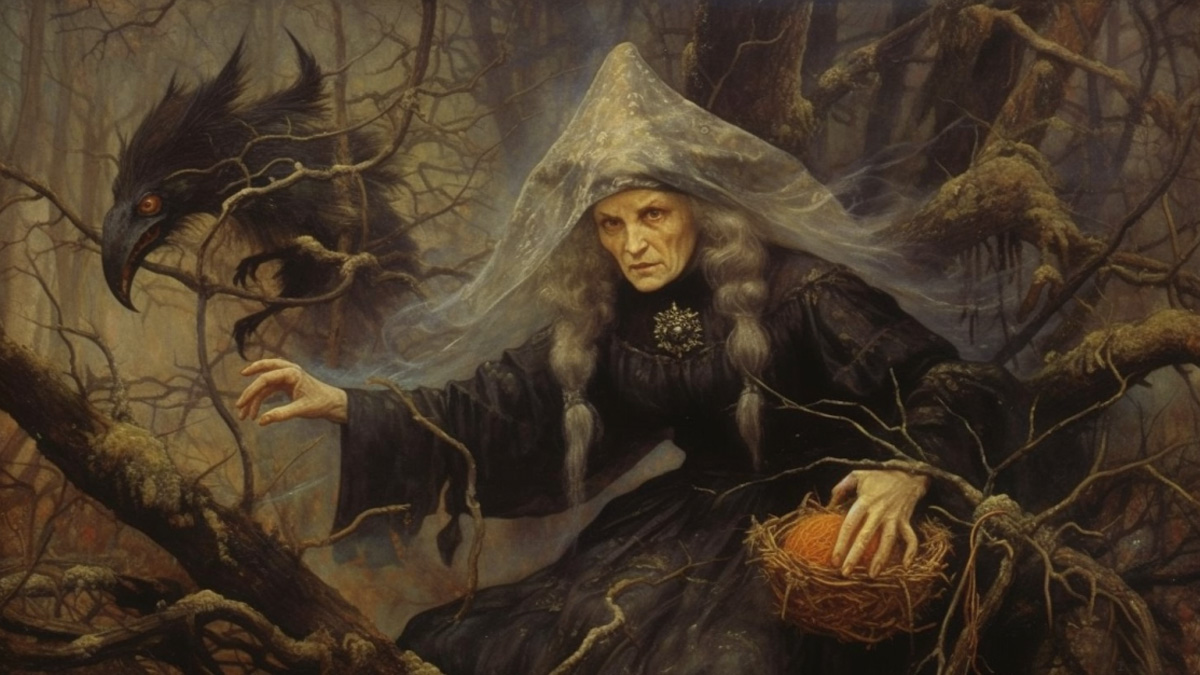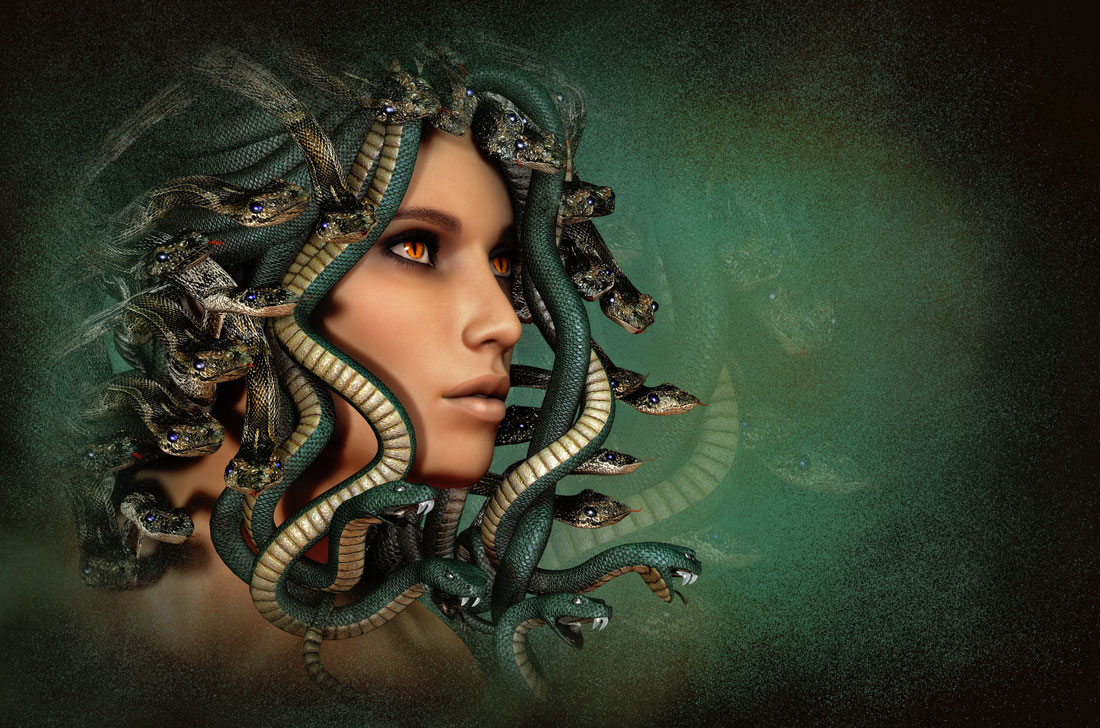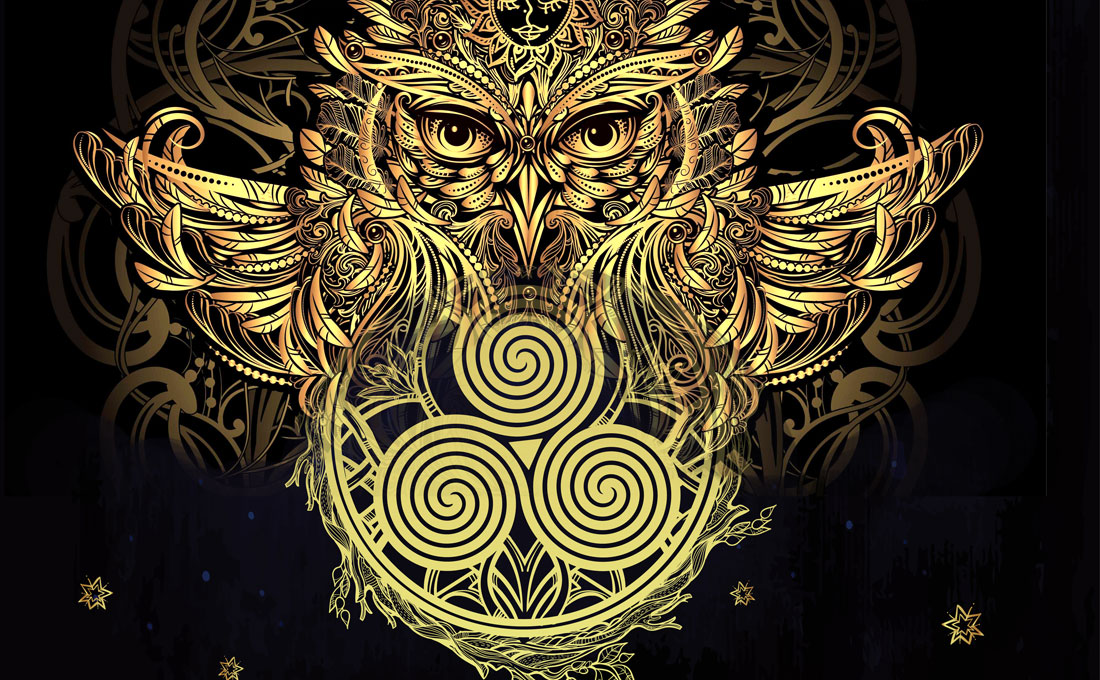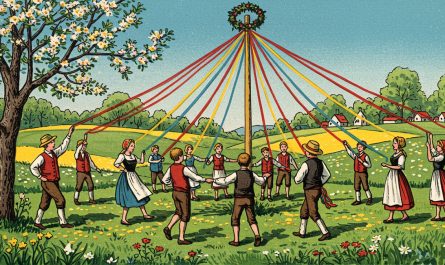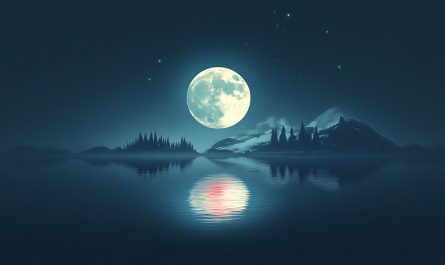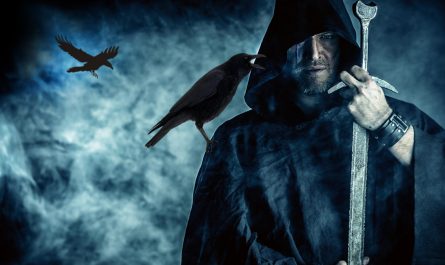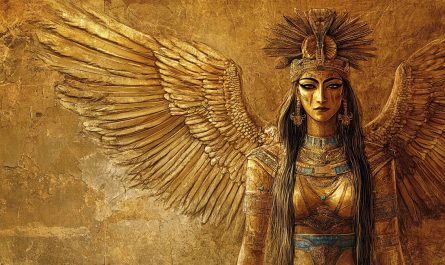Last Updated on October 7, 2024 by Avia
One name stands out among the myriad mythical beings that captivate our imagination: Baba Yaga. With her twisted hut perched atop chicken legs and reputation as a fearsome witch, Baba Yaga has intrigued and terrified generations with her enigmatic presence. But who is Baba Yaga, exactly? What is the meaning behind this enigmatic figure? Join us on a journey through history and folklore as we delve deep into the world of Baba Yaga to uncover her secrets and unravel the mysteries surrounding her name. So grab your broomstick (or chicken leg!), and let’s soar into the captivating tale of Baba Yaga!
Table of Contents
- Avia’s Experience With Baba Yaga
- Who is Baba Yaga?
- History of Baba Yaga
- The Story of Baba Yaga in Slavic Folktale
- What is the Significance of Baba Yaga’s House in the Slavic Folktale?
- Is Baba Yaga a Cannibal or Eat Children? If So, Why?
- What Archetype is Baba Yaga?
- Does Baba Yaga Identify as a Male or Female?
- Male Version of Baba Yaga (Koshchei Bessmertnyi)
- Baba Yaga in John Wick Movies
- What is the Importance of Baba Yaga in Culture and Community?
- Lessons Baba Yaga Teaches Children (and Adults)
- Other Versions of Baba Yaga in Other Cultural Stories and Folktales Around the World
- Symbols of Baba Yaga
- Frequently Asked Questions About Baba Yaga
- Closing Thoughts About “Who is Baba Yaga?”
Avia’s Experience With Baba Yaga
A million moons ago, I went back to university to finish my degree. At that time, I took an anthropology course that utilized folklore and fairy tales to decipher elements in various cultures around the world. If you think that class sounds cool – you are right. It was the coolest.
As you may have guessed, I was first introduced to and asked the question, “Who is Baba Yaga?” in that college course. I was immediately intrigued by her. However, that’s no surprise. I love unconventional and fearsome figures. Seeing Baba Yaga from all angles and her influence on Slavic culture was a real blast for me.
Imagine my delight and surprise when I heard the term Baba Yaga used in the John Wick movies. It boggled me a bit because Baba is traditionally a female, while Wick was certainly all male. To speak to that boggling, I talk more about gender roles and the male version of Baba Yaga further in this article, so keep reading!
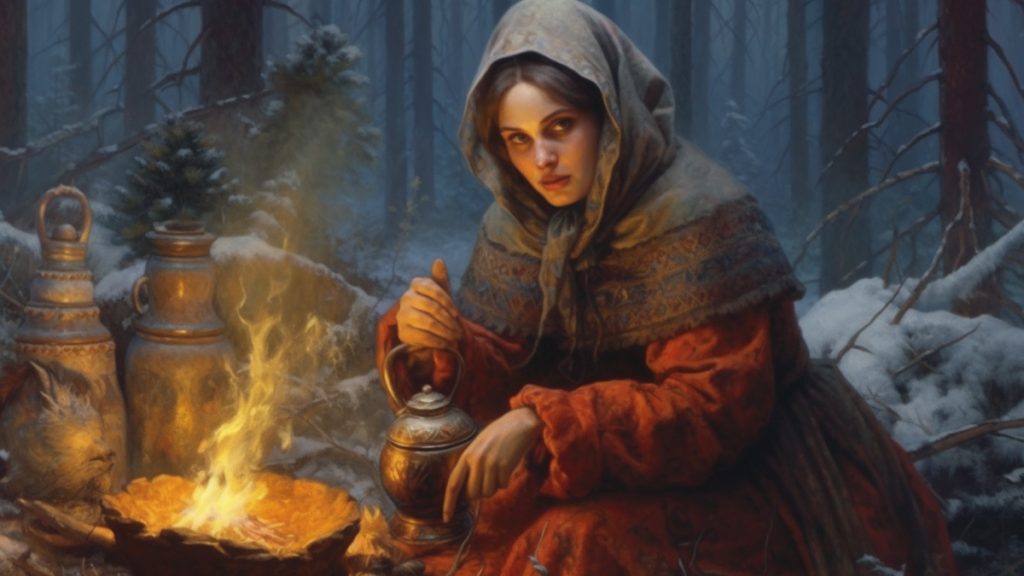
Who is Baba Yaga?
Who is Baba Yaga? This enigmatic figure from Slavic folklore has fascinated people for centuries. She is often depicted as a witch, but there is so much more to her than that. Baba Yaga is a complex character with multiple layers of meaning and symbolism.
In the stories, Baba Yaga is portrayed as an old hag who lives in a house that stands on funky, animated legs (often chicken legs, but sometimes human legs or hound dog legs) around at will. She possesses magical powers and wisdom beyond human comprehension. Some tales depict her as a helper or mentor to those who seek her out, while others portray her as a terrifying antagonist.
There are conflicting accounts about whether or not Baba Yaga was a cannibal who ate children. While some stories mention this aspect, it is important to remember that folklore evolves and varies across different regions. The act of eating children may represent a metaphorical consumption of innocence or ignorance rather than literal cannibalism.
Baba Yaga embodies the archetype of the crone, representing wisdom, power, and unpredictability. As an ancient female figure in folklore, she challenges traditional gender roles by defying societal expectations placed upon women.
History of Baba Yaga
How does history answer the question, “Who is Baba Yaga?” History shows us she is a fascinating Slavic folklore character with a rich and intriguing history spanning centuries. Her origins can be traced back to ancient pagan beliefs and the mythology of pre-Christian Eastern Europe.
In these tales, she is often depicted as an enigmatic figure who dwells in a mysterious hut deep within the forest. The stories about her vary greatly, with different regions presenting their own unique interpretations.
One theory suggests that Baba Yaga may have originated from the Slavic goddess of death and rebirth, known as Morana or Mara. Over time, this goddess evolved into the complex and multifaceted character we know today as Baba Yaga.
Throughout history, she has been portrayed as both a wise old woman and a fearsome witch. She possesses great powers and knowledge of magic, making her an intriguing figure in Slavic folklore.
Her role in these tales often involves testing the courage and resourcefulness of those who encounter her. Whether she aids or hinders them depends on their actions and intentions.
The stories featuring Baba Yaga have been passed down through generations, captivating audiences with their blend of enchantment and darkness. Despite her sometimes terrifying nature, Baba Yaga remains an enduring symbol in Slavic culture.
As time goes on, new adaptations emerge that bring this legendary character into contemporary contexts, such as movies like John Wick. Through these modern interpretations, Baba Yaga continues to capture our imaginations while reminding us of our cultural heritage.
The Story of Baba Yaga in Slavic Folktale
The story of Baba Yaga typically begins with a young protagonist who must complete a series of impossible tasks in order to seek her wisdom or assistance. The journey to Baba Yaga’s house is often treacherous, filled with enchanted forests, talking animals, and magical beings.
Some versions of the folktale indicate the protagonist must navigate through numerous tests set by Baba Yaga herself. These tests may involve solving riddles or completing daunting physical challenges that push their limits.
Baba Yaga is portrayed as ambiguous – sometimes helpful and wise, other times cruel and deceitful. She possesses powerful magic and is known for her ability to shape-shift into various forms, such as an old hag or a beautiful maiden.
Her iconic house plays a significant role in the folktale. With its eerie appearance and peculiar design, it serves as both a trap for those who are unworthy and a sanctuary for those who prove themselves deserving.
Contrary to popular belief, Baba Yaga’s reputation as a child-eating witch may be exaggerated. While some versions do depict her devouring children or using them in sinister ways, others present her with more restraint – perhaps testing their worthiness rather than outright consuming them.
Baba Yaga embodies the witch archetype – representing both darkness and light within human nature. She symbolizes wildness, independence, and adaptability. She challenges societal norms while also dispensing wisdom gained from years of experience.
Although traditionally depicted as female due to linguistic conventions (the word “baba” meaning “old woman”), there are instances where Baba Yaga appears in male form under different names like Koshchei Bessmertnyi (we’ll go into him more deeply in a minute). This adds to the complexity and fluidity of her character.
What is the Significance of Baba Yaga’s House in the Slavic Folktale?
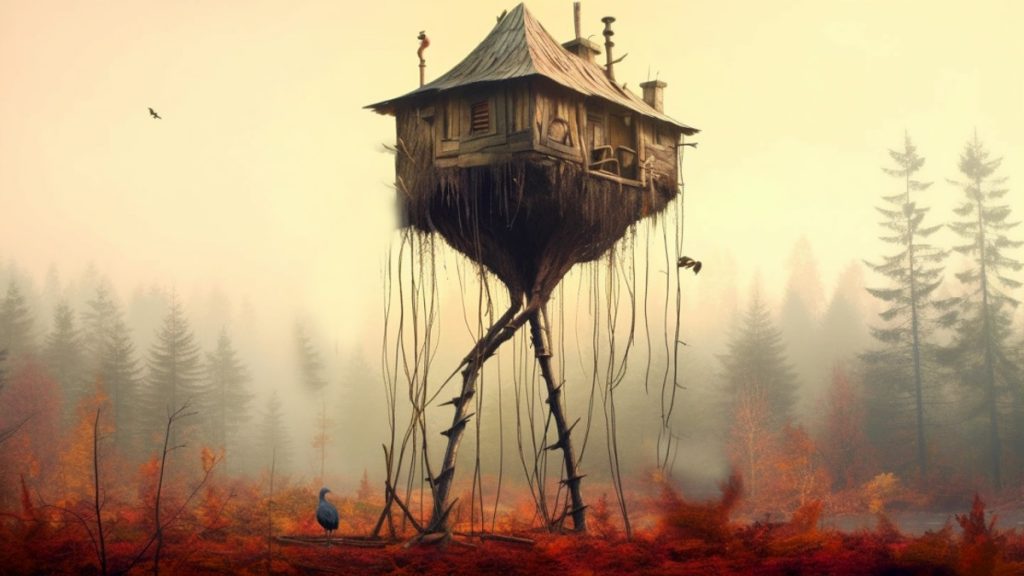
Baba Yaga’s house posits great significance in the Slavic folktale, adding an element of mystery and danger to the story. As mentioned, the house itself is depicted as a peculiar structure with chicken legs that allow it to move around, creating an eerie and unsettling atmosphere.
The symbolism of the house cannot be understated. It represents the liminal space between the ordinary world and the realm of magic and transformation. It stands on legs and symbolizes mobility and adaptability, reflecting Baba Yaga’s elusive nature.
The mobile nature of Baba Yaga’s house serves as a metaphor for her elusive and unpredictable nature. It represents her ability to traverse different realms, blurring the line between reality and fantasy. This adds to the sense of trepidation experienced by those who encounter her.
Furthermore, Baba Yaga’s house acts as a test for those who seek her help or cross paths with her. It often presents challenges or riddles that must be solved before one can gain access to its interior. This symbolizes the trials and obstacles one must overcome on their personal journey or quest for knowledge.
The enchanted qualities of Baba Yaga’s house also reflect her power and wisdom. It serves as a manifestation of her supernatural abilities and connection to nature. In some versions of the tale, the house is said to possess magical objects or artifacts that aid in fulfilling wishes or granting protection.
Is Baba Yaga a Cannibal or Eat Children? If So, Why?
One of the most intriguing aspects of Baba Yaga’s character in Slavic folklore is her reputation as a cannibal who eats children. While this may sound horrifying, it is important to understand the deeper symbolism behind these tales.
In Slavic folklore, Baba Yaga represents nature’s wild and unpredictable forces. She is often depicted as an old crone with iron teeth and a bony nose, living deep in the forest in a house that, apparently, can pick up sticks and run away. This imagery alone evokes fear and uncertainty.
The stories surrounding Baba Yaga’s consumption of children can be seen as cautionary tales. Children are often portrayed as curious and naive, venturing into the dangerous unknown without proper guidance or respect for nature’s power. Baba Yaga serves as a reminder that recklessness can have dire consequences.
By emphasizing her appetite for children, these folktales reveal the need for obedience and respect towards elders and authority figures. They teach us to be cautious when navigating unfamiliar territories and to heed warnings from those wiser than us.
It is crucial to remember that these stories are not meant to instill fear but rather impart valuable life lessons. The notion of Baba Yaga consuming children symbolizes a loss of innocence due to ignorance or disobedience rather than actual physical harm inflicted upon them.
Baba Yaga’s portrayal showcases humanity’s fascination with exploring themes of danger, darkness, and morality within our collective storytelling traditions. By delving into these narratives with an open mind, we gain insight into different cultures’ beliefs while also reflecting on universal truths about human nature itself
What Archetype is Baba Yaga?
With her enigmatic and complex character, Baba Yaga embodies several archetypes in Slavic folklore. One of the most prominent archetypes associated with her is that of the “Wise Old Woman.” She possesses immense wisdom and knowledge, often dispensing advice or granting magical gifts to those who seek her help. However, this archetype also carries a sense of unpredictability and ambiguity.
Another archetype that can be attributed to Baba Yaga is the “Wild Woman” or the “Dark Goddess.” She resides deep within the forest, surrounded by nature’s untamed elements. This archetype represents primal instincts and serves as a reminder of humanity’s connection to the natural world. Baba Yaga’s wild nature symbolizes both danger and liberation.
Furthermore, Baba Yaga can be seen as a representation of feminine power and independence through her autonomy. She lives alone in her eccentric house – an emblematic image that signifies self-reliance and non-conformity. As an unconventional figure who does not adhere to societal norms or expectations, she challenges traditional gender roles.
In some interpretations, Baba Yaga may even embody aspects of the trickster archetype due to her unpredictable behaviors and mischievous tendencies. Her actions often serve as tests for those who encounter her—a way to separate the worthy from the unworthy.
It is important to recognize that these archetypes are fluid concepts that intertwine within Baba Yaga’s character. Her multifaceted personality allows for various interpretations depending on cultural context and individual perspectives.
Does Baba Yaga Identify as a Male or Female?
Baba Yaga, the enigmatic figure of Slavic folklore, defies traditional gender norms and expectations. She is often portrayed as an old crone with wild hair, a crooked nose, and iron teeth. While Baba Yaga’s appearance may align more closely with female attributes, her identity transcends simple categorization.
In Slavic mythology, Baba Yaga is considered a powerful witch or sorceress with immense magical abilities. Her name itself is derived from the word “baba,” which can mean both “old woman” and “grandmother.” This ambiguity adds to her mystique and leaves room for interpretation.
Some interpretations suggest that Baba Yaga represents the duality of femininity – embodying both nurturing qualities associated with motherhood and the fierce independence often attributed to crones. Others argue that she personifies the ancient goddess archetype, linked to nature and wisdom beyond conventional gender roles.
It is up to individual interpretation whether Baba Yaga identifies strictly as male or female. As a mythical character deeply embedded in folklore narratives spanning centuries, she transcends such limitations and embodies a complexity that challenges our understanding of gender norms.
Male Version of Baba Yaga (Koshchei Bessmertnyi)
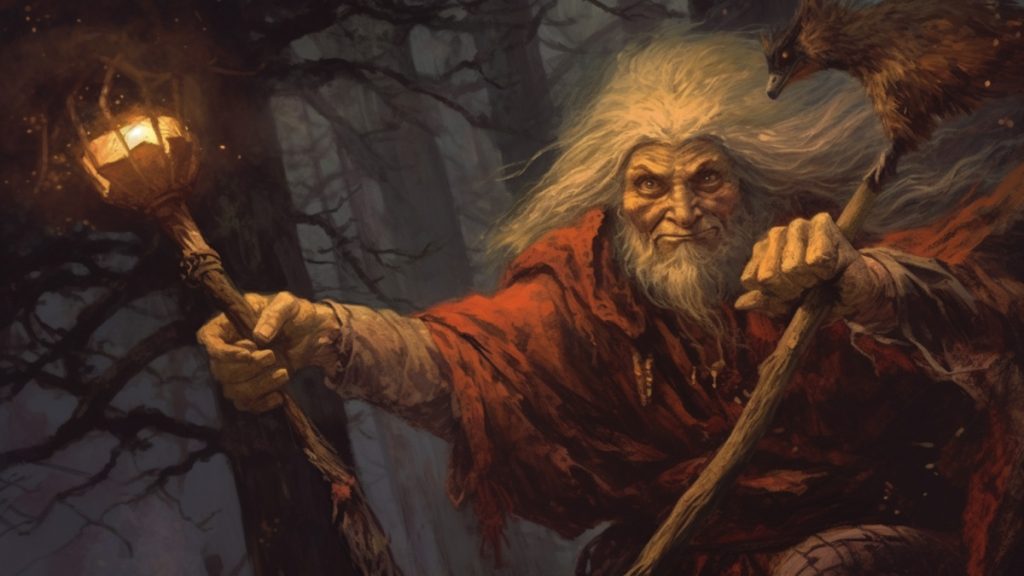
We’ve got good groundcover on answering the question, “Who is Baba Yaga?” – but is there a male version? Yes, indeedy there is. The male version of Baba Yaga brings a whole new dimension to the mystical world of Russian tales.
In various stories, Koshchei Bessmertnyi is often portrayed as an immortal sorcerer and antagonist. Unlike Baba Yaga, who is depicted as an old hag living in a hut on the edge of town, Koshchei appears as a powerful and cunning figure with dark magical abilities.
One fascinating aspect of Koshchei’s character is his immortality. He is said to possess a hidden object or animal that grants him eternal life. This element adds intrigue and suspense to the narratives involving him.
Although not as well-known as Baba Yaga, Koshchei (or Koshchey) has also made appearances in popular culture. Some may recall encountering this mysterious figure in the popular video game, The Witcher or even seeing him in the Hellboy comic book series.
With his enigmatic persona and supernatural powers, Koshcehi Bessmertnyi continues to captivate audiences with his unique portrayal within Slavic folklore. Exploring these lesser-known characters expands our understanding of the rich tapestry of mythical beings that exist within different cultural traditions around the world.
Baba Yaga in John Wick Movies
So, we’re to the point where I pick up on my state of flummox when I heard Baba referenced in the John Wick films. Baba Yaga has been given a fresh and intriguing interpretation within the realm of modern cinema. In the popular John Wick film series, our protagonist is referred to as “Baba Yaga” by his Russian adversaries.
While this might initially seem peculiar, given that Baba Yaga is traditionally depicted as an old crone in Slavic folklore. But the filmmakers cleverly utilize this moniker to emphasize Wick’s lethal abilities and feared reputation.
In these films, ‘Baba Yaga’ becomes synonymous with ‘the Boogeyman,’ a personification of fear itself. This seems apt considering John’s deadly professional acumen, which terrorizes even the most hardened criminals.
So while it may not directly correlate with traditional interpretations of Baba Yaga from Slavic lore, its use within the context of John Wick serves as a testament to how far-reaching and versatile this figure has become across different cultures and mediums.
What is the Importance of Baba Yaga in Culture and Community?
When we ask, “Who is Baba Yaga,” we’re really asking about her prominence and importance in culture and community, which cannot be underestimated. She is a powerful figure who represents the mysteries and complexities of life. In Slavic folklore, she embodies the untamed forces of nature, both frightening and awe-inspiring.
Baba Yaga serves as a reminder that there is darkness within all of us and the potential for growth and transformation. Her presence challenges us to confront our fears and overcome obstacles on our journey toward self-discovery.
In some versions of her stories, Baba Yaga acts as a symbol of wisdom and guidance. She teaches valuable lessons about resilience, resourcefulness, and adaptability. Through her stories, we learn that we can find the inner strength to persevere despite adversity.
Furthermore, Baba Yaga highlights the importance of respecting nature and living in harmony with it. She reminds us that we are not separate from the natural world but integral to it.
Baba Yaga plays a vital role in shaping cultural beliefs and values by offering insights into human nature’s complexity while emphasizing the need for balance between lightness and darkness. Her influence extends beyond folklore to inspire creativity across various art forms such as literature, music, theater, and film.
Lessons Baba Yaga Teaches Children (and Adults)
One lesson that Baba Yaga imparts is the importance of self-reliance. In many stories, she challenges those seeking her help or guidance. These trials often require individuals to tap into their own resourcefulness and inner strength in order to overcome obstacles. Through these encounters, Baba Yaga reminds us that we have the power within ourselves to find solutions and navigate life’s difficulties.
Another lesson she teaches is the value of intuition and trust in one’s instincts. Baba Yaga is known for her unpredictable nature and seemingly contradictory actions. She encourages individuals to listen to their gut feelings and follow their own path rather than blindly conforming to societal expectations. This message resonates particularly strongly with children who may struggle with peer pressure or societal norms.
Furthermore, Baba Yaga reinforces the idea that appearances can be deceiving. Her haggard appearance belies her wisdom and profound knowledge of the light and dark aspects of human existence. This serves as a reminder not to judge others based solely on external appearances but instead look beneath the surface for true understanding.
Additionally, Baba Yaga teaches empathy by challenging preconceived notions about good versus evil. While she might appear frightening or even malevolent at times, she also displays moments of kindness towards those who demonstrate genuine compassion towards others.
Perhaps one of the most significant lessons imparted by Baba Yaga is embracing change and embracing our own wild nature. As a symbol of transformation herself – seen through her shapeshifting abilities – she encourages us to accept change and revel in it as an opportunity for growth and self-discovery.
Other Versions of Baba Yaga in Other Cultural Stories and Folktales Around the World
Although predominantly known in Slavic folklore, Baba Yaga also has counterparts in other cultures. In Russian culture, she is often depicted as an old hag living deep within the forest. However, similar characters can be found in different forms across various mythologies.
Norse
In Norse mythology, there’s a character called “Gygr.” She shares many similarities with Baba Yaga – both are powerful and mysterious women who reside in remote locations. They possess magical abilities and are often associated with nature.
Romanian
In Romanian folklore, there is Muma Pădurii or “Mother of the Forest,” who bears resemblances to Baba Yaga. Like her Slavic counterpart, Muma Pădurii lives deep within the woods and possesses supernatural powers.
African
Additionally, African folklore introduces us to Anansi’s grandmother or Aunt Nancy from Ashanti mythology. This trickster figure displays traits akin to Baba Yaga – cunningness combined with wisdom.
These variations showcase how such archetypes transcend cultural boundaries and resonate with people worldwide. The common threads that run through these stories highlight the universal themes of mystery, power, and feminine strength that captivate our imaginations regardless of where we come from.
Symbols of Baba Yaga
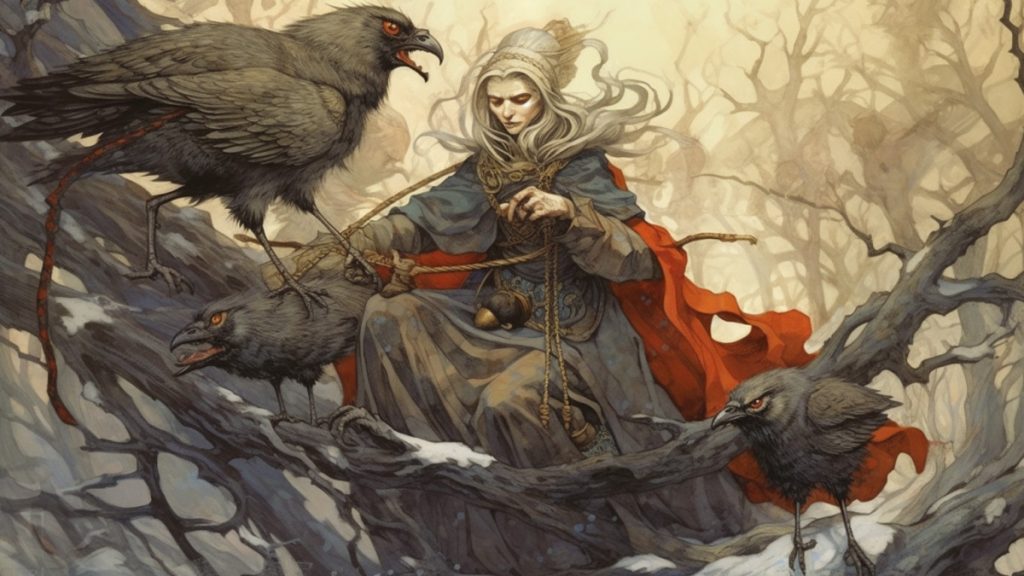
Baba Yaga, the mysterious and enigmatic figure from Slavic folklore, is adorned with various symbols that help unravel her intriguing nature. These symbols offer insight into her character and powers, adding depth to the tales in which she appears.
The Baba Yaga House
Baba Yaga’s house is one of the most intriguing symbols associated with her. It is said to stand on chicken legs and move around at will, making it impossible to find or predict its location. This unconventional mode of transportation adds to Baba Yaga’s mysterious and otherworldly nature.
The house itself is often depicted as old and decrepit, covered in moss, and surrounded by an eerie sense of darkness. Its dilapidated appearance reflects Baba Yaga herself – a powerful figure operating outside conventional society’s boundaries.
Inside the house, things are no less strange. The rooms seem to shift and change, defying any sense of logic or order. It is said that those who enter Baba Yaga’s house must navigate through countless traps and obstacles before they can reach her.
The symbolism behind Baba Yaga’s ever-moving house suggests that she cannot be contained or controlled. She exists on her own terms, free from the constraints imposed by others.
In folklore, houses often symbolize stability, security, and comfort. However, Baba Yaga’s constantly moving dwelling subverts these expectations. It represents chaos and unpredictability – qualities that align with her role as a powerful witch capable of both good deeds and malicious acts.
Baba Yaga’s house serves as a visual representation of her enigmatic nature and refusal to conform to societal norms. Its ability to uproot itself speaks volumes about her power and independence within the realm of folklore legends.
Horse
In many tales featuring this mysterious character, she is often depicted riding through the night sky on her trusty steed. The horse serves as both transportation and a representation of power.
Baba Yaga’s horse is no ordinary equine companion. It possesses magical qualities that enable it to traverse vast distances in an instant. Its wild mane and fiery eyes reflect its untamed nature, mirroring Baba Yaga’s own unpredictable personality.
This mystical horse embodies duality – it can be gentle and docile, yet also fierce and unstoppable when needed. Baba’s horse symbolizes freedom and independence but also serves as a reminder of the dangers lurking in the wilderness.
In some stories, the horse acts as a guide for those who seek Baba Yaga’s wisdom or aid. It leads them through dense forests and treacherous terrains, ensuring their safe arrival at Baba Yaga’s secluded dwelling.
The presence of the horse in tales involving Baba Yaga reminds us that journeys are not always straightforward or easy. Like life itself, they can be filled with challenges and uncertainty. But with determination and guidance from unexpected sources – such as Baba Yaga’s magical steed – we may find our way through even the darkest forests.
Cats
Cats play a significant role in the symbolism of Baba Yaga. These mysterious and independent creatures are often associated with magic, intuition, and transformation. In many folktales featuring Baba Yaga, cats are depicted as her loyal companions or familiars.
One common depiction of cats in relation to Baba Yaga is their ability to see through illusions and reveal the truth. They act as both protectors and guides for those who seek out Baba Yaga’s wisdom. With their keen senses and sharp instincts, they navigate the mystical realm alongside her.
Cats symbolize duality and balance – traits that align closely with Baba Yaga. Just like the witch’s enigmatic nature, cats possess both nurturing qualities and an untamed wildness that keeps them elusive to fully understand.
Moreover, cats are often portrayed as shape-shifters in folklore, just like their mistress. They can transform into other animals or even take on human form at will. This further emphasizes the transformative powers associated with Baba Yaga’s character.
Cats represent mystery, intuition, transformation, protection, and guidance within the symbolism of Baba Yaga. Furthermore, cats embody a sense of hidden knowledge that lies beyond ordinary perception through their connection with this legendary figure from Slavic folklore.
Crows
Crows are often associated with darkness and mystery, making them a fitting symbol for Baba Yaga. These intelligent birds have long been considered messengers between the living world and the spirit realm.
Many Slavic folklore tales depict crows as Baba Yaga’s loyal companions and helpers. They fly ahead of her, scouting the area and alerting her to any danger or intruders. They serve as her watchful guardians with their keen eyesight and sharp claws.
But there is more to these black-feathered creatures than meets the eye. Crows are known for their resourcefulness and adaptability. They can survive in various environments, including dense forests where Baba Yaga resides.
Their presence signifies a connection to nature itself – untamed and wild like Baba Yaga herself. Just as she is closely tied to the wilderness, crows are also seen as symbols of freedom and independence.
The crow’s dark plumage also represents transformation and rebirth in many cultures. This aligns with Baba Yaga’s role as a wise old witch who possesses ancient knowledge of life cycles and secrets of magic.
Snake
The snake is a fascinating symbol often associated with Baba Yaga. In fact, “Yaga” is sometimes translated to mean serpent or snake. The snake represents transformation, rebirth, and wisdom in many folktales and mythologies. It slithers through the grass, shedding its old skin to reveal a shiny new one underneath.
In Baba Yaga’s lore, the snake embodies her connection to nature and her ability to navigate between different realms. Just like the serpent sheds skin, Baba Yaga can shed her human form and transform into various creatures or objects at will.
The snake also represents primal instincts and hidden knowledge. As a wise witch who dwells in the wilderness, Baba Yaga possesses ancient wisdom that has been passed down through generations. She holds secret knowledge of healing herbs and powerful spells that she uses for both good and ill intent.
Furthermore, snakes are often associated with cunningness and deception. They move stealthily through their surroundings without drawing attention until it’s too late. Similarly, Baba Yaga is known for being unpredictable and mysterious. Her intentions are not always clear-cut, as she may help or hinder those who cross her path.
Mortar and Pestle
These ancient tools hold a special significance to Baba Yaga, representing both power and wisdom.
In Baba Yaga’s tales, the mortar and pestle are not just ordinary kitchen utensils; they possess magical properties that aid her in brewing potent potions and concoctions. The mortar serves as a vessel for grinding herbs, roots, and other ingredients, while the pestle acts as a tool to crush them into fine powders.
But these tools go beyond their practical use. They represent Baba Yaga’s connection to nature and her ability to transform ordinary substances into extraordinary elixirs. The act of grinding and blending ingredients in the mortar brings together disparate elements, creating something new altogether – much like how Baba Yaga weaves together different aspects of life.
Furthermore, the mortar itself is seen as a symbol of feminine energy – nurturing yet powerful. It embodies the idea of transformation through creation. Baba Yaga harnesses her inner strength to bring about change as she grinds away at various components with precision and purpose.
The pestle complements this symbolism by serving as an extension of Baba Yaga’s willpower. With each strike against the ingredients within the mortar, she asserts control over her craft – shaping reality according to her desires.
Broom (sometimes a mop)
There is more to the broom and mop than meets the eye. In folklore, brooms have long been associated with protection against evil spirits. They are said to ward off negative energy when placed by the door or hung upside down.
However, the broom or mop takes on a different role for Baba Yaga. It becomes a means for her to travel great distances quickly, enabling her to easily travel through the vast wilderness.
It is also worth noting that in some tales, Baba Yaga’s flying mortar and pestle are accompanied by either a broom or mop. This combination showcases her supernatural abilities and hints at her connection to traditional domestic tasks.
While seemingly mundane objects in our everyday lives, the broom or mop serves as powerful symbols within Baba Yaga’s world – representing both control over one’s surroundings and protection against malevolent forces
Hearth
At first glance, it may seem odd that a figure as mysterious as Baba Yaga would be linked to something as seemingly ordinary as a hearth. However, this symbol holds a deeper meaning within her story. The hearth is where the family gathers for nourishment and connection; it is the heart of the home.
For Baba Yaga, who often resides in the isolated wilderness or deep forests, the hearth becomes a sanctuary amidst the chaos. It acts as a focal point of stability amid her unpredictable nature. It also serves as a place for transformation – where she can brew potions or cast spells over flickering flames.
Moreover, the hearth represents Baba Yaga’s connection to primal forces – fire being one of them. Fire brings both light and destruction; it has power over life and death. In many tales featuring Baba Yaga, she controls these forces with mastery.
Wilderness, Forest
Another symbol closely associated with Baba Yaga is the wilderness, particularly the dense forests where she resides. The forest represents danger and transformation in folklore, where one can easily get lost or encounter magical beings. It serves as a backdrop for Baba Yaga’s mysterious nature and acts as a metaphor for navigating life’s challenges.
The wilderness also embodies the untamed aspects of human existence—the wildness within us all that craves freedom from societal constraints. In this sense, Baba Yaga can be seen as an embodiment of our primal instincts, reminding us to embrace our true selves without fear or hesitation.
In many stories featuring Baba Yaga, characters must journey through the wilderness to find her dwelling. This journey often involves facing trials and tribulations meant to test their courage and resolve. Through these transformative experiences, individuals discover their inner strength and wisdom—an essential lesson taught by Baba Yaga herself.
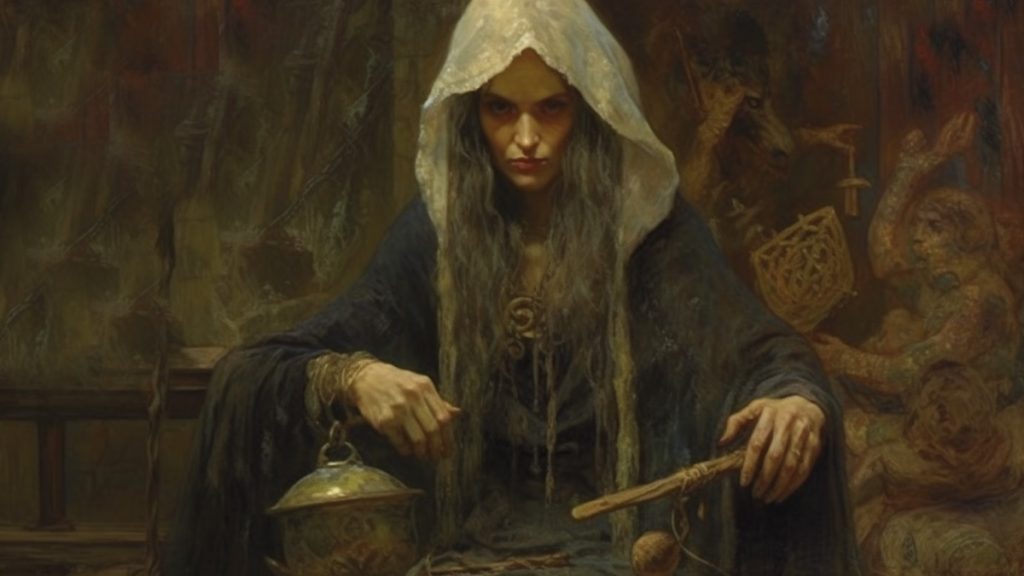
Frequently Asked Questions About Baba Yaga
Baba Yaga is not a real person in the literal sense. She is a Slavic folklore and mythology character, representing an archetypal figure of an old witch or crone.
The notion that Baba Yaga eats children comes from the tales and legends surrounding her. However, it’s important to remember that these stories are symbolic rather than literal. The idea of consuming children represents transformation and initiation into adulthood.
The name “Baba Yaga” has various interpretations in different Slavic languages, but it generally translates to “grandmother witch.” Yaga is also a derivative of Yagat, which means uncovering flaws or faults. Some cultures recognize her name to mean “nature mother witch” or “woman who works magic in nature.” Overwhelmingly (as we see in the John Wick movies), the name is meant to conjure caution and sometimes incite fear in anyone who hears her name.
Baba Yaga teaches us many valuable lessons through her stories: resilience in difficult times, resourcefulness against adversity, and wisdom gained from experience are just a few examples. I particularly appreciate the lessons about embracing our natural, primitive, feral selves. Maybe not to the extent Baba does in the folktales, but the moral of living with nature and being confident with ourselves (regardless of societal backlash) feels important.
Closing Thoughts About “Who is Baba Yaga?”
Baba Yaga is a fascinating and enigmatic figure in Slavic folklore. Her history and significance have captivated the imaginations of people for centuries. She left an indelible mark on cultural stories and folktales, from her iconic house on chicken legs to her reputation as a person to be feared.
In conclusion, the allure surrounding her persists because she encapsulates timeless aspects of humanity: fear, wisdom-seeking journeys, and transformational growth.
She will continue to be an enduring figure in storytelling and a source of inspiration for generations to come. That said, thanks (as always) for reading. I hope these insights into who is Baba Yaga prove illuminating to you!
Mighty brightly,

© Copyrighted. All Rights Reserved.

